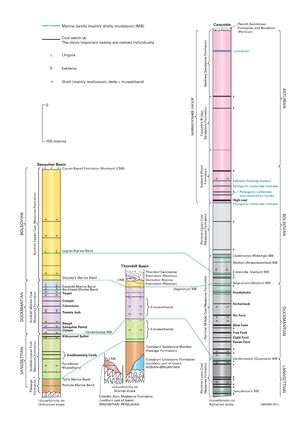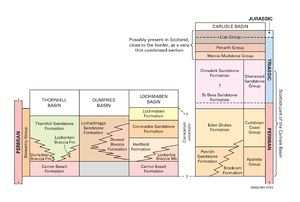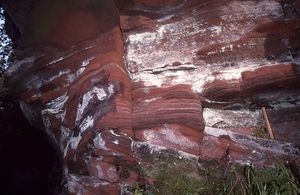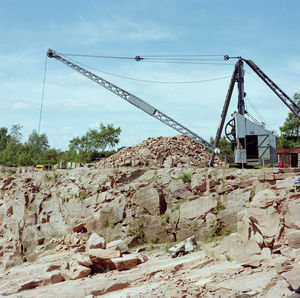Stewartry Group Permian-Triassic basins, Southern Uplands
| Stone, P, McMillan, A A, Floyd, J D, Barnes, R P, and Phillips, E R. 2012. British regional geology: South of Scotland. Fourth edition. Keyworth, Nottingham: British Geological Survey. |
Stewartry Group, introduction











Rocks of the Stewartry Group, mostly red sandstones and breccio-conglomerates, are confined to a series of fault-bounded, north-west- or north-trending basins that cut across the Southern Uplands massif: Stranraer, Ballantrae, Thornhill, Dumfries, Lochmaben, Moffat and the Snar Valley (P912359). The basin boundary faults followed reactivated Caledonian trends in response to broadly east–west extension, as mainly half-graben structures developed on either side of a compound horst underpinned by the Galloway granitic plutons. For the most part, the boundary faults do not appear to have an earlier history of reactivation and in places cut folded Dinantian strata and displace the North Solway Fault, one of the most active of the early Carboniferous syndepositional faults. It would seem probable that there was rotation of the regional stress field through Carboniferous times and into the Permian Period.
Stranraer Basin
The Stranraer Basin is a half-graben bounded to the east by the Loch Ryan Fault. Thick, massive breccio-conglomerate of the Permian Loch Ryan Formation is exposed along the Loch Ryan coast to the north-west of Stranraer. Geophysical evidence shows that the basin closes northwards and is asymmetric, with up to 1200 m of strata at its eastern margin. The formation rests unconformably on Carboniferous or Lower Palaeozoic rocks, the latter providing the locally sourced, angular and subangular clasts of wacke sandstone that dominate the breccia (P772045). A northerly provenance has been deduced for the deposit, which is interpreted to be the product of either debris flow or sheet flood in alluvial fans. In broad agreement an overall southwards pattern of sedimentary distribution is the southwards increase in the proportion of red sandstone interbeds in the succession. There is also a suggestion that the highest strata preserved become younger southwards, with possible Triassic red sandstone (correlated with the Sherwood Sandstone Group of the Carlisle Basin — see below) recorded in a borehole in Luce Bay.
Ballantrae Basin
In Ayrshire between Ballantrae and Bennane Lea (NX 092 859) some 750 m of lower Permian red beds form coastal exposures at the margin of the mostly offshore Ballantrae Basin. At the base of the succession, the Park End Breccia Formation comprises about 250 m of red breccio-conglomerate with rare silty sandstone lenses. Over 90 per cent of the clasts are of wacke sandstone with the remainder being composed of mudstone, chert, basalt and various granitic and gabbroic coarse-grained igneous rocks. The conglomerates are probably braided stream deposits. Within the formation is a conformable layer of doleritic rock, 1 m thick, which may be either a lava flow or a sill. It shows a much higher degree of alteration than nearby Palaeogene dykes and is thought to be a manifestation of the early Permian magmatism seen elsewhere in the region.
Conformably overlying the Park End Breccia is the Corseclays Sandstone Formation, which comprises about 500 m of red, micaceous, fine-grained sandstone and siltstone. The strata represent channel and overbank deposits of ephemeral streams. Along most of the inland, eastern margin of its outcrop, the formation is faulted against the Ordovician Ballantrae Complex, but in the north, at Bennane Lea, the highest part of the Permian succession laps onto the Ordovician rocks. There, clasts of spilitic basalt and serpentinite are contained in a red sandstone matrix, and define the Bennane Lea Breccia Member.
Sanquhar Basin
The youngest rocks seen in the Sanquhar Basin are olivine basalt lavas that form a small outlier in its south-eastern extremity where they unconformably overlie strata of the Scottish Middle Coal Measures Formation. The lavas, no more than 40 m thick, are assigned to the lower Permian Carron Basalt Formation, which has a much more extensive outcrop to south in the Thornhill Basin (see below). The basaltic lavas are also of similar composition, and are probably equivalent in age, to those seen farther north-west within the Mauchline Volcanic Formation of the Mauchline Basin in the Midland Valley. There, sedimentary rocks interbedded with the basalts have yielded a flora that is currently regarded as early Permian.
Thornhill Basin
The Thornhill Basin was initiated as a complex graben structure controlled by the reactivation of faults from the broadly north–south trending Caledonian set. However, for the most part the faults are overstepped by the basinal strata so that the currently exposed margins of the outlier commonly show Permian beds resting unconformably on Ordovician or Silurian strata. At the base of the Permian sequence, in the northern part of the basin, thin olivine basalt lava flows with interbedded conglomerate and sandstone make up the Carron Basalt Formation and are overlain unconformably by fluvial breccio-conglomerate and sandstone of the Durisdeer Breccia Formation (P912356 and P912360). The Durisdeer Breccia interdigitates with and passes up into aeolian sandstones of the Thornhill Sandstone Formation. In the deepest part of the basin, west of the Carronbridge Fault, geophysical modelling indicates the maximum combined thickness of Permian and underlying Carboniferous strata is about 400 m. In a small subsidiary outlier (c. 3 km2) at Locherben, to the east of the main basin, a local breccia development towards the base of the Thornhill Sandstone Formation is assigned to the Locherben Breccia Formation.
In the Thornhill Basin, the olivine basalts of the Carron Basalt Formation are typically much weathered and comprise a few thin lavas, no more than 20 m in total thickness. At the type section in the Carron Water (NS 885 017 to 888 022), in the northern part of the basin, thin lava flows are interbedded with streamflood breccias and sandstones and either overlie Coal Measures strata or overstep them to rest directly on Lower Palaeozoic wacke sandstone with marked unconformity. Angular clasts within the breccias are of basalt and wacke sandstone. A thin amygdaloidal lava is also exposed in the subsidiary Permian to Carboniferous outlier of Locherben, at the base of the Locherben Breccia Formation. About 6 km to the south-south-east of Locherben, remnants of lava overlie a red volcanic breccia in three small outliers close to the confluence of Windyhill Burn and the Water of Ae (NX 975 905). These remnants, together with the presence of the Carron Basalt Formation in another small outlier around Lakehead Farm (NY 001 880) close to the north-west margin of the Lochmaben Basin (P912359), and of locally derived basalt-dominated breccias elsewhere around the margin of that basin (see below), demonstrate the considerable original extent of early Permian volcanicity.
In all of its outcrops, the lava of the Carron Basalt Formation typically comprises a lower aphanitic layer and an upper amygdaloidal layer. The tops of the flows are fissured, infilled and overlain by medium to fine-grained laminated sandstone and fine-grained breccia. In hand specimen, the rocks exhibit a red speckling due to the alteration of the abundant olivine crystals.
In the northern part of the Thornhill Basin, the Durisdeer Breccia Formation, a sequence of sandy breccias, fluviatile sandstones and siltstones, overlies the Carron Basalt Formation (P912360). The type section in the Hapland Burn (NS 888 023 to 889 025) reveals interbedding of tabular, laminated sandstones and sandy breccia in which wind-facetted clasts, up to 20 cm in diameter, are mostly of locally derived basalt; also present, but rare, are clasts of wacke-type sandstone derived from Lower Palaeozoic strata. The clasts are contained in a silty-sand matrix with up to 10 per cent ‘millet seed’, aeolian quartz and basalt sand grains, and the formation passes upwards into the aeolian Thornhill Sandstone Formation (see below).
The general depositional environment of the Durisdeer Breccia Formation was the lower part of a wadi fan complex in which ephemeral streams flowed outwards from the edges of fans across a desert floor. The deposits range from the coarse breccias, formed in streamflood channels cut into a basalt pediment, to the fine-grained, planar and cross-laminated sandstones and siltstones of desert-floor lakes and braided streams. At East Morton (NS 885 008), a disturbed sequence of thinly laminated sandstone, siltstone and mudstone is interpreted as an inland sabkha or lake deposit disrupted by the solution of evaporite minerals which may once have cemented the sediments.
In the small outlier of Locherben to the east of the main Thornhill Basin, breccio-conglomerate with a predominance of wacke sandstone clasts, derived from a local source, are assigned to the Locherben Breccia Formation. This unit contains wacke-type sandstone clasts up to 10 cm diameter with sporadic larger clasts of purple amygdaloidal basalt, but generally the breccia lacks basaltic detritus. The breccia matrix is composed of subangular to well-rounded grains of quartz sand with up to 20 per cent of ‘millet seed’ character. The Locherben Breccia Formation built up as a series of sheetflood deposits from wadi fans. The formation interdigitates with and passes up into aeolian dune sandstone of the Thornhill Sandstone Formation.
The Thornhill Sandstone Formation crops out across a large part of the Thornhill Basin and comprises up to 200 m of red, cross-bedded, aeolian dune sandstones. The sandstones were formerly well exposed in quarries at Gatelawbridge and Closeburn which supplied building stone. Cross-bedding in the sandstones shows a consistent north-easterly wind direction, in common with the other major Permian basins. The type section, a 30 m thick sequence in the Crichope Burn at Crichope Linn (NX 911 955) (P258072) shows characteristically well sorted, fine to coarse grained, laminated (‘pin-striped’) quartz arenite in tabular to wedge-shaped, cross-stratified sets. Individual quartz grains are well rounded and are accompanied by a small proportion of feldspar and basalt grains, which are also rounded. The basal 1.5 m of the formation is not exposed in the burn but in the nearby BGS Crichope Linn Borehole (NX 909 955), aeolian sandstones overlie a basal 1.4 m thick, coarse-grained, fluviatile sandstone with rounded pebbles of quartz and flakes of red mudstone, which rests with angular unconformity on Coal Measures strata.
The aeolian sandstones are readily distinguished from fluviatile sandstones by the absence of mica, their generally good sorting, the excellent sorting of individual laminae of contrasting grain size, the presence of thick cross-bedded units and the scarcity of silt or clay layers. Typically two types of aeolian sequences are present. Dune deposits consist principally of medium- to fine-grained sandstones in cross-bedded units bounded by tabular and trough-shaped surfaces. Interdune accretion deposits consist of parallel-laminated coarse-grained sandstones alternating with finer-grained laminae; they have a bimodal grain-size distribution.
Dumfries Basin
The sequence of breccio-conglomerate and red sandstone that fills the Dumfries Basin is estimated from geophysical modelling to attain, in the centre of the basin, a maximum thickness of about 1.5 km (P912361). The basin is a broadly symmetrical, graben structure extending north-west to south-east, though the marginal faults are mostly overstepped by the basinal strata. The Doweel Breccia Formation crops out in the south and west of the basin and the Locharbriggs Sandstone Formation crops out in the north and east. Although in places the Locharbriggs Sandstone Formation is seen to underlie the Doweel Breccia Formation, the boundary is strongly diachronous and the two are interpreted to interfinger in the subsurface.
The lower part of the Doweel Breccia Formation comprises an interbedded sequence of breccia, pebbly fluviatile sandstone and some aeolian sandstone. Locally, breccias within this interbedded sequence crop out as prominent ridges, whilst an exposure within Castledykes Park, Dumfries (NX 976 746), includes a cross-section of a stream-flood channel containing a gravel breccia with a sandy matrix (P220789 and P220788). The erosive channel base cuts down into underlying aeolian cross-bedded sandstone and is, in turn, overlain by bedded sandstone and pebbly sandstone interpreted as sheet-flood deposits. Many of the Silurian sandstone clasts in the Doweel Breccia are sharply angular (P001430).
The upper part of the Doweel Breccia Formation is lithologically less varied than the lower part. In an old railway cutting (NX 9383 7388) near the eponymous Doweel Farm, a section typical of the formation’s upper part comprises very thick beds of breccio-conglomerate with thin interbeds of red laminated sandstone. In the cutting, angular clasts of locally derived, Lower Palaeozoic sandstone, mudstone and granodiorite, up to about 25 cm across, are matrix supported within fine-grained red sandstone. The sandstone beds, which contain some well-rounded aeolian grains, are discontinuous and pass laterally into clast-supported coarse breccio-conglomerates. The matrix-supported rudaceous rocks are interpreted as debris flow deposits that accumulated in a basin-margin, alluvial-fan setting with deposition of the overlying sandstones during the waning stages of flow. The clast-supported breccio-conglomerates probably originated through the reworking, by winnowing, of the sediment surface prior to deposition of the overlying debris flow.
Vertical and lateral variation in clast composition within the breccias allows them to be distinguished as the products of debris flows and alluvial fans fed from the west by two separate wadi valleys. This division is made possible by the local derivation of the clasts. In the south-west of the basin they are mostly of granodiorite and metasedimentary rocks derived from the Criffel Pluton and its thermal aureole. In the north-west they are predominantly of Lower Palaeozoic sedimentary and ‘Caledonian’ dyke rocks.
Progradation of alluvial fan deposits into the basin centre is likely to have been associated with source rejuvenation by movement of the faults that define the western margin of the basin. The relatively small maximum clast size and apparent absence of a down-fan decrease in maximum grain size, are considered to reflect reworking of already accumulated breccias after source uplift. Interbedding of alluvial fan deposits with aeolian sandstones demonstrates the advance of wind-blown deposits over the fan surface and the persistence of arid ‘desert’ conditions. However, an increase in both the proportion of debris flow deposits and fine-grained matrix sediment toward the top of the sequence, together with an absence there of reworked aeolian sand grains, may indicate a change towards more humid conditions.
The Locharbriggs Sandstone Formation crops out along the north-east side of the Dumfries Basin though natural exposure is scarce. The formation unconformably overlies Lower Palaeozoic strata and is interbedded with or underlies the Doweel Breccia Formation. Although the maximum thickness of the formation is not proven, 63 m was penetrated by water boreholes in the vicinity of Holywood (NX 960 816). The type section of the formation is at Locharbriggs North Quarry (NX 990 810) (P001579). Here, and in two adjacent quarries, 25 m of red, cross-bedded, fine-grained sandstone were worked for building stone. At the beginning of the 21st century, the North Quarry was disused and partly water filled, with a new, active quarry developed a little to the south. The cross-bedding sets are mostly wedge shaped or tabular and between 0.5 and 2.0 m thick. The aeolian character of the sandstone is inferred, in part, from the rounded to subrounded and frosted nature of the component grains is supported by the record of reptilian trackways. First, second and third order bounding surfaces may be attributed to the development of large draas (large-scale, composite dune bedforms), migration of dunes over a draa, and small-scale erosional discontinuities associated with changing airflow patterns, respectively (P912362).
Lochmaben Basin
From geophysical evidence, the Lochmaben Basin contains some 1300 m of sedimentary strata (P912361). It is a graben structure, though the faulted south-western margin is now most apparent, the north-east marginal faults having been overstepped by the basinal strata. To the north-west of the main basin, in the small outlier (c. 1 km2) around Lakehead, olivine basalt lava and lava breccia of the Carron Basalt Formation (see section on Thornhill, above) rest unconformably on Silurian strata and are succeeded by the red clastic rocks of the Hartfield Formation. These overstep the lavas in the Lakehead outlier to rest directly on the Silurian rocks with marked unconformity, and carry that relationship into the main Lochmaben Basin where the formation crops out on the basin’s western, northern and eastern margins. The Hartfield Formation comprises up to 170 m of red, laminated and cross-laminated micaceous sandstone interbedded with pebbly sandstone and lenses of breccio-conglomerate. The sandstone forms thick beds, some brick red with dune cross-bedding, and is relatively fine, with many frosted and rounded, aeolian quartz grains. The clasts in the pebbly sandstone and breccio-conglomerate range up to about 3 cm across and are mostly tabular. They are matrix-supported in red, silty sandstone but are aligned parallel or near parallel to bedding and so define a crude lamination. Lithologies commonly present in the clast are red or grey mudrock, grey micaceous sandstone, cream-coloured quartzite and, locally, amygdaloidal basalt. On the eastern margin of the basin near Lockerbie, the lowermost part of the Hartfield Formation is formed by the Lockerbie Breccia Member, up to 15 m of red-brown breccio-conglomerate with thin interbeds of red sandstone. The distinctive assemblage of lithic clasts in this member includes reddened limestone, wacke sandstone, mafic volcanic rocks, siltstone, mudstone and rounded quartz pebbles.
The Corncockle Sandstone Formation incorporates the majority of the Lochmaben Basin sequence. It is about 900 m thick and is made up of fine- to medium-grained, well-sorted, red quartzose sandstone with large-scale aeolian cross-bedding. Some of the best sections are seen in Corncockle Quarry (NY 085 870) which has long supplied good building stone. Exposed bedding planes in the quarry formerly revealed well-preserved reptilian trackway trace fossils assigned to the ichnogenus Chelichnus, examples of which were also recorded from Locharbriggs Quarry near Dumfries (see above). Trackways of this ichnogenus are well known from the middle Permian, Cornberger Sandstone (Germany) and the lower Permian, Coconino Sandstone (Arizona, USA).
At Lochmaben, in the centre of the eponymous basin, the Corncockle Sandstone is overlain by the Lochmaben Formation, 50–60 m of red, irregularly bedded siltstone and fine-grained, locally cross-bedded sandstone. The Lochmaben Formation also includes beds of coarse-grained sandstone with well-rounded and frosted, aeolian grains contained in a fine matrix, and some beds of breccio-conglomerate; there are slump structures, small gypsiferous nodules, and near-horizontal gypsum-cemented veins.
Moffat Basin
The Moffat Basin is a narrow elongate trough containing about 200 m of breccio-conglomerate and red sandstone assigned to the Hartfield Formation. The strata are partly unconformable on a highly irregular Lower Palaeozoic surface and partly faulted against these older rocks along reactivated, north-north-west-trending Caledonian faults. Basal breccias, interpreted as scree deposits, contain clasts that are mostly derived from the underlying Lower Palaeozoic sandstone, but a few clasts contain Carboniferous fossils and so suggest that the Permian strata may in part have been deposited on Carboniferous sedimentary rocks. The basal breccias are directly overlain by interbedded fine-grained sandstones and breccio-conglomerate (with clasts of wacke sandstone and mudstone) that were deposited by sinuous braided streams. This fluvial sequence is then overlain by aeolian sandstone, finely laminated, fine grained and cross-bedded, with interbeds of evenly laminated coarse sandstone.
Snar Valley outlier
Up to 700 m of moderately well-sorted breccio-conglomerate, containing mostly subangular clasts of wacke-type sandstone, mudstone and chert, are present in the small oulier (c.3 km2) cut by the Snar Water between Leadhills and Crawfordjohn. There is no overt fault control on the outlier and the Permian strata appear to occupy a palaeotopographical depression in the underlying Ordovician turbidite sequence. The Permian beds make up the Glendouran Breccia Formation and are thought to have originated as debris-flow and sheet-flood deposits.
Bibliography
Anderson, T B, Parnell, J, and Ruffell, A H. 1995. Influence of basement on the geometryof Permo-Triassic basins in the north-west British Isles. 103–122 in Permian and Triassic Rifting in North-west Europe. Boldy, S A R (editor). Geological Society of London SpecialPublication, No. 91.
Brookfield, M E. 1978. Revision of the stratigraphy of Permian and supposed Permian rocks of southern Scotland. Geologischen Rundschau, Vol. 67, 110–149.
Brookfield, M E. 1979. Anatomy of a lower Permian aeolian sandstone complex, southern Scotland. Scottish Journal of Geology, Vol.15, 81–96.
Brookfield, M E. 1980. Permian intermontane basin sedimentation in southern Scotland. Sedimentary Geology, Vol. 27, 167–194.
Brookfield, M E. 2004. The enigma of fine-grained alluvial basin fills: the Permo-Triassic (Cumbrian Coastal and Sherwood Sandstone groups) of the Solway Basin, NW England and SW Scotland). International Journal of Earth Science (Geologischen Rundschau), Vol. 93, 282–296.
Holliday, D W, Warrington, G, Brookfield, M E, McMillan, A A, and Holloway, S. 2001. Permo-Triassic rocks in boreholes in the Annan–Canonbie area, Dumfries and Galloway, southern Scotland. Scottish Journal of Geology, Vol. 37, 97–113.
Holliday, D W, Holloway, S, McMillan, A A, Jones, N S, Warrington, G, and Akhurst, M C. 2004. The evolution of the Carlisle Basin, NW England and SW Scotland. Proceedings of the Yorkshire Geological Society, Vol. 55, 1–19.
Holliday, D W, Jones, N S, and McMillan, A A. 2008 Lithostratigraphical subdivision of the Sherwood Sandstone Group (Triassic) of the north-eastern part of the Carlisle Basin, Cumbria, and adjacent parts of Dumfries & Galloway, UK. Scottish Journal of Geology, Vol. 44, 97–110.
Holloway, S. 1985. The Permian. 26–30 in Atlas of onshore sedimentary basins in England and Wales: post-Carboniferous tectonics and stratigraphy. Whittaker, A (editor). (Glasgow: Blackie and Son.)
McKeever, P J A. 1994. A new fossil vertebrate trackway from the Permian of Dumfries and Galloway. Scottish Journal of Geology, Vol. 30, 11–14.
Stone, P. 1988. The Permian successions at Ballantrae and Loch Ryan, south-west Scotland. Report of the British Geological Survey, Vol. 9, No 2, 13–18.